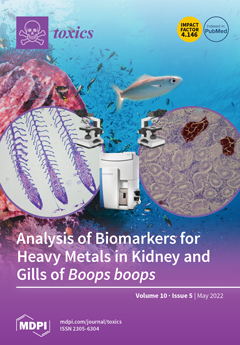The study was aimed at assessing the influence of urban informal settlement on trace element accumulation in road dust from the Ekurhuleni Metropolitan Municipality, South Africa, and their possible health implications. The concentration of major and trace elements was determined using the wavelength dispersive XRF method. The major elements in descending order were SiO
2 (72.76%), Al
2O
3 (6.90%), Fe
2O
3 (3.88%), CaO (2.71%), K
2O (1.56%), Na
2O (0.99%), MgO (0.94%), MnO (0.57%), TiO
2 (0.40%), and P
2O
5 (0.16%), with SiO
2 and P
2O
5 at above-average shale values. The average mean concentrations of 17 trace elements in decreasing order were Cr (637.4), Ba (625.6), Zn (231.8), Zr (190.2), Sr (120.2), V (69), Rb (66), Cu (61), Ni (49), Pb (30.8), Co (17.4), Y (14.4), Nb (8.6), As (7.2), Sc (5.8), Th (4.58), and U (2.9) mg/kg. Trace elements such as Cr, Cu, Zn, Zr, Ba, and Pb surpassed their average shale values, and only Cr surpassed the South African soil screening values. The assessment of pollution through the geo-accumulation index (Igeo) revealed that road dust was moderately to heavily contaminated by Cr, whereas all other trace elements were categorized as being uncontaminated to moderately contaminated. The contamination factor (CF) exhibited road dust to be very highly contaminated by Cr, moderately contaminated by Zn, Pb, Cu, Zr, and Ba, and lowly contaminated by Co, U, Nb, Ni, As, Y, V, Rb, Sc, Sr, and Th. The pollution load index (PLI) also affirmed that the road dust in this study was very highly polluted by trace elements. Moreover, the results of the enrichment factor (EF) categorized Cr as having a significant degree of enrichment. Zn was elucidated as being minimally enriched, whereas all other trace elements were of natural origin. The results of the non-carcinogenic risk assessment revealed a possibility of non-carcinogenic risks to both children and adults. For the carcinogenic risk, the total CR values in children and adults were above the acceptable limit, signifying a likelihood of carcinogenic risk to the local inhabitants. From the findings of this study, it can be concluded that the levels of trace elements in the road dust of this informal settlement had the possibility to contribute to both non-carcinogenic and carcinogenic risks, and that children were at a higher risk than the adult population.
Full article






